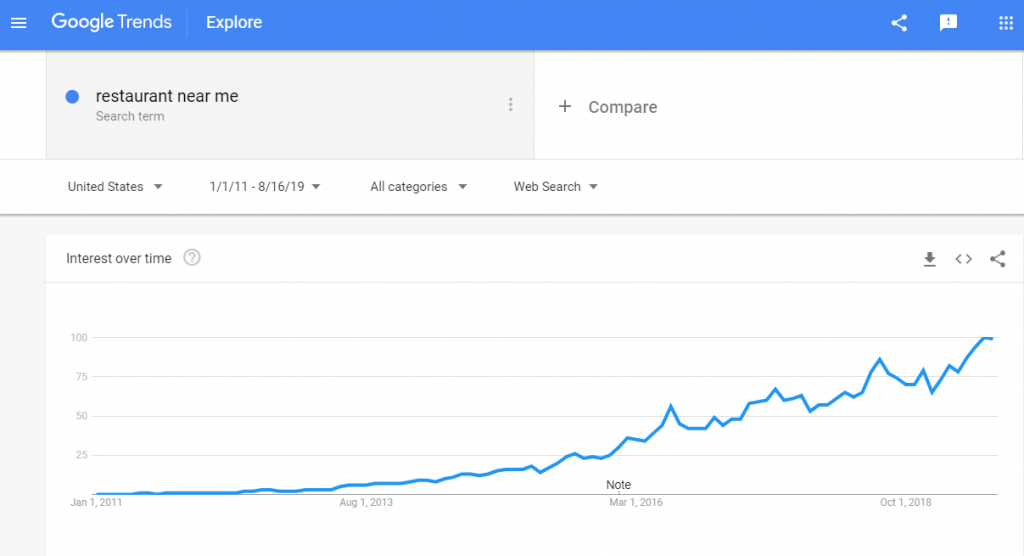Near Me Keywords: Unlocking Powerful Local SEO Success
The pursuit of local visibility is no simple task, it’s like finding your beacon amidst a sea of competing signals.
Business owners often overlook the profound impact that ‘near me‘ keywords hold within the local ranking game, but it’s basically a key that unlocks the door to opportunistic foot traffic.
 What Are “Near Me” Keywords?
What Are “Near Me” Keywords?
“Near me” keywords are search terms that include the phrase “near me” or similar variations. These keywords are used by consumers who are looking for businesses or services in their immediate vicinity. For example, someone might search for “coffee shops near me”, “plumbers near me” or “digital marketing companies near me” to find local options.
Why Are “Near Me” Keywords Important For Local SEO?
- Relevance: By incorporating “near me” keywords into your website content, you signal to search engines that your business is relevant to local searches. This increases the chances of your website appearing in the search results when someone searches for a product or service in your area.
- User Intent: When someone includes “near me” in their search query, it indicates that they have a strong intent to make a purchase or visit a local business. By optimizing your website for these keywords, you can attract highly motivated and ready to convert customers.
- Mobile Optimization: With the rise of mobile devices, “near me” searches have become even more prevalent. People often use their smartphones to find businesses while on the go. By targeting “near me” keywords, you can tap into this mobile driven search behavior and capture local customers.
Understanding “Near Me” Search Behavior
 When consumers are in immediate need of products or services, they frequently turn to search engines with a local intent, appending “near me” to their queries. This search behavior reflects an expectation of timely and geographically convenient solutions, signaling a readiness to engage in transactions close to their located proximity.
When consumers are in immediate need of products or services, they frequently turn to search engines with a local intent, appending “near me” to their queries. This search behavior reflects an expectation of timely and geographically convenient solutions, signaling a readiness to engage in transactions close to their located proximity.
Incorporating “near me” into your SEO strategy aligns with the user’s journey, distinctly catering to those at the intent driven stage of seeking local business information. By making use of this pivotal query attribute, businesses position themselves at the forefront of a consumer’s search results at precisely the moment when the decision to proceed with a purchase is most likely to occur.
The Psychology Behind Local Searches
The local search phenomenon is, at its essence, an extension of human behavior, geared towards seeking immediate gratification. We instinctively favor proximity, equating nearness with convenience, and more broadly, reliability.
Our cognitive processes incline us to simplify decisions, and “near me” keywords play directly into this preference. The phrase taps into our desire for quick, accessible solutions, these keywords help guide our choices, ensuring that what we seek feels within reach.
Consumers innately associate proximity with speed and reliability.
Recognizing the important role of ‘near me’ searches allows businesses to intercept customers at a critical juncture. By understanding that people often equate the physical closeness of a service with its ease and dependability (rooted in the principle of behavioral psychology), services can strategically position themselves to answer this innate consumer call. This nuanced understanding can significantly improve the impact of a local SEO strategy.
How “Near Me” Queries Impact Visibility
Search queries with “near me” reinforce the business presence in local digital surroundings and elevate a brand’s visibility within its immediate geographical area.
“Near me” keywords act as digital signposts for physical locations that bridge online search behavior to offline foot traffic.
Businesses using “near me” in their SEO benefit from Google’s preference for providing users with results that are most relevant to their current location. This geo-targeting capability can drastically increase a business’s visibility to potential customers in proximity.
The strategic incorporation of “near me” keywords into a business’s SEO initiatives yields a symbiotic relationship between consumer convenience and business visibility. When optimized adeptly, these keywords not only enhance a business’s online presence but also its potential to attract physical consumers, supported by the underlying behavioral inclination towards local and convenient options. Consequently, for businesses targeting local markets, “near me” is indispensable in securing a vantage point in an increasingly competitive digital battle for business.
Optimizing For “Near Me” Keywords
To effectively capitalize on “near me” keywords, businesses should integrate these search terms seamlessly throughout their website content, including product pages, meta titles, and descriptions. Precise application of such locational phrases helps pinpoint the business in local searches, making it more likely to appear when potential customers are in close proximity and use search queries with a local intent. Keywords should be naturally embedded to maintain the content’s readability while aligning with the user’s search intent for nearby services or products.
Incorporating “near me” into a business’s local SEO strategy must also extend to its Google My Business profile, ensuring that location particulars are accurately and thoroughly identified. A consistent NAP (Name, Address, Phone number) across online platforms, alongside careful “near me” keyword placement, builds sufficient signals to search engines about the business’s geographical relevance, thereby heightening the establishment’s local search prominence and improving the likelihood of attracting customers in the vicinity.
Integrating Local Keywords Strategically
 Using “near me” keywords is not simply about placement, it’s about understanding searcher intent.
Using “near me” keywords is not simply about placement, it’s about understanding searcher intent.
- Research local search trends to uncover the most effective “near me” phrases relevant to your business.
- Integrate these phrases seamlessly into website content, including headings, titles, and meta descriptions.
- Optimize your Google My Business listing with “near me” keywords tailored to your location and offerings.
- Foster local backlinks with these keywords, strengthening your website’s local SEO footprint.
- Regularly update on-page content to remain pertinent in local search results and address evolving trends.
Algorithms are wise to keyword stuffing, demanding more natural organic integration, having a localized keyword strategy improves visibility, drawing the community to your doorstep.
Leveraging Location Based Metadata
Metadata acts as a vital navigational tool for local SEO strategies, it informs search engines about the geographical relevance of a web page.
Since 2016, Google’s keen algorithmic eye prioritizes location based metadata, refining search results for a higher degree of accuracy. Therefore, embedding this metadata into a site’s framework becomes imperative for businesses seeking local dominance.
Now, it’s not enough to include ‘near me’ in on-page content, one must also harness the power of structured data marked up with location specific details, which will enhance search engine understanding.
Getting control of this can thrust a business into the spotlight, for example, using schema.org‘s local business markup can distinctly display a company’s location, hours, and services in search engine results.
This in conjunction with metadata optimization can help bridge the gap between a business and its community, anchoring its digital presence locally.
The Role Of Google My Business In Local SEO
Google My Business (GMB) or now known as Google Business Profile is an essential key in the area of local SEO. It provides a platform for businesses to present crucial information, including their physical location, hours of operation, contact details, and services offered, in a centralized and publicly accessible manner. A well optimized GMB profile significantly enhances a business’s visibility and credibility in local search results, facilitating an efficient connection with potential customers in the vicinity. By leveraging the nuances of GMB, from accurate listing details to the solicitation of customer reviews, businesses can effectively amplify their local prominence and ensure they are readily discoverable when users conduct ‘near me’ searches.
Setting Up For “Near Me” Success
To optimize for “near me” searches, foundational SEO practices must be meticulously implemented.
- Claim and verify your Google My Business (GMB) listing: Ensure your business is accurately represented on Google Maps and Search.
- Incorporate “near me” in metadata: Title tags and Meta descriptions should subtly include “near me” phrases.
- Localize website content: Tailor your website’s copy to reflect the local vernacular and landmarks.
- Strategize keyword placement: Use “near me” keywords effectively within your website’s content and headings.
- Collect and manage reviews: Encourage satisfied customers to leave positive reviews, boosting your local credibility.
- Optimize for mobile: Ensure your website is responsively designed for mobile devices, as “near me” searches are often made on the go.
- Create local content: Publish blog posts or articles relevant to your local area to strengthen local relevance.
Local citations and backlinks form the bedrock of “near me” keyword strategy, achieving “near me” prominence is a diligent balance between relevance and proximity.
Regularly Updating Your GMB Profile
 Maintaining an accurate and up to date Google My Business (GMB) profile is paramount to ensure prominence in local search results. A current profile reflects a reliable and operational business, garnering user trust and engagement.
Maintaining an accurate and up to date Google My Business (GMB) profile is paramount to ensure prominence in local search results. A current profile reflects a reliable and operational business, garnering user trust and engagement.
The dynamic nature of businesses commands that your GMB profile be a living document, adapting to changes such as new working hours, services, or seasonal promotions. Consistently fresh information not only appeases potential customers but also signals to search engines that your business remains active and relevant, thus favoring it in search rankings.
Furthermore, Google’s algorithms favour content that is not only accurate but also rich and informative. By regularly posting updates, offers, and events, your business keeps its audience engaged while simultaneously boosting its visibility in local search results, such engagement demonstrates to search engines the continual relevance of your business.
Lastly, incorporating new photos and responding promptly to reviews are practices that inject your GMB profile with life. Regular visual content updates invite user interaction and enhance your profile’s appeal, meanwhile, managing customer feedback exhibits exemplary customer service and can influence search engine trust, ultimately improving your positioning in “near me” search queries.
Measuring The Impact Of “Near Me” SEO Efforts
To gauge the effectiveness of “Near Me” SEO strategies, careful tracking of key performance indicators (KPIs) is essential. For local businesses, incremental gains in search engine ranking positions, heightened website traffic, and an increase in conversion rates can indicate successful optimization for “near me” searches. Regular monitoring of these metrics reveals trends and helps refine tactics for continued improvement.
Additionally, employing tools like Google Analytics and Search Console offers insightful data around user behavior and search query performance. These platforms can display the volume of “near me” queries directing traffic to your site and the corresponding bounce rate. Further, observing customer journey pathways, from initial “near me” search to conversion, can spotlight the efficacy of your local SEO optimization, enabling data led decisions that enhance your strategies over time.
Tracking Local Keyword Rankings
Utilizing a comprehensive analytic platform is vital to understand where your local business stands in search results for “near me” queries. These platforms can provide granular data on your search visibility and identify how “near me” keywords contribute to your digital footprint, then by consistently monitoring this data, you can identify trends and optimize accordingly.
Diligent analysis of these metrics can offer insights into your local search engine optimization (SEO) performance and Pinpoint your position in search results can inform strategic adjustments needed to enhance your local presence.
Remember, ranking for “near me” queries fluctuates due to multiple factors, including algorithm updates (that require proactive adjustment) and competition levels, so regular tracking is therefore indispensable.
Frequent monitoring helps you recognize shifts in local search trends, which can be pivotal for maintaining a competitive edge. It also enables you to respond promptly to any potential threats to your local ranking.
A crucial aspect of tracking involves comparing your rankings against competitors, by benchmarking your performance enables you to gauge your progress and identify strategies that might be contributing to your competitors’ successes.
Ultimately, the goal is to ensure that users’ searches for services “near me” consistently bring up your business and precise tracking facilitates refined strategy implementation and helps maintain high local search rankings.
Analyzing Conversion Rates From Local Searches
Conversion rates from local searches are paramount in understanding a business’s online impact.
- Track Conversion Paths:Begin by monitoring how customers find your business through local searches and what actions they take thereafter.
- Evaluate Phone Call Metrics:Examine the call volume from “click to call” functions on local listings as a direct indicator of search to conversion efficiency.
- Assess Physical Visits:Geofencing technology can provide insights into how many searchers visit your storefront after finding you online.
- Review Online Interactions:Analyze actions such as appointment bookings or specific inquiries that originate from local search results.
- Benchmark Against Competitors:Compare your local search conversion rates with industry counterparts to identify areas for improvement.
It’s crucial to differentiate between traffic and valuable engagement.
Pinpointing where local searches lead to tangible business outcomes optimizes marketing efforts.
Conclusion
Incorporating “near me” keywords into your SEO strategy can significantly boost your visibility in local search results. By optimizing your website and online presence for these keywords, you can attract highly motivated local customers and grow your business. Stay ahead of the competition and unlock the power of “near me” keywords today!













